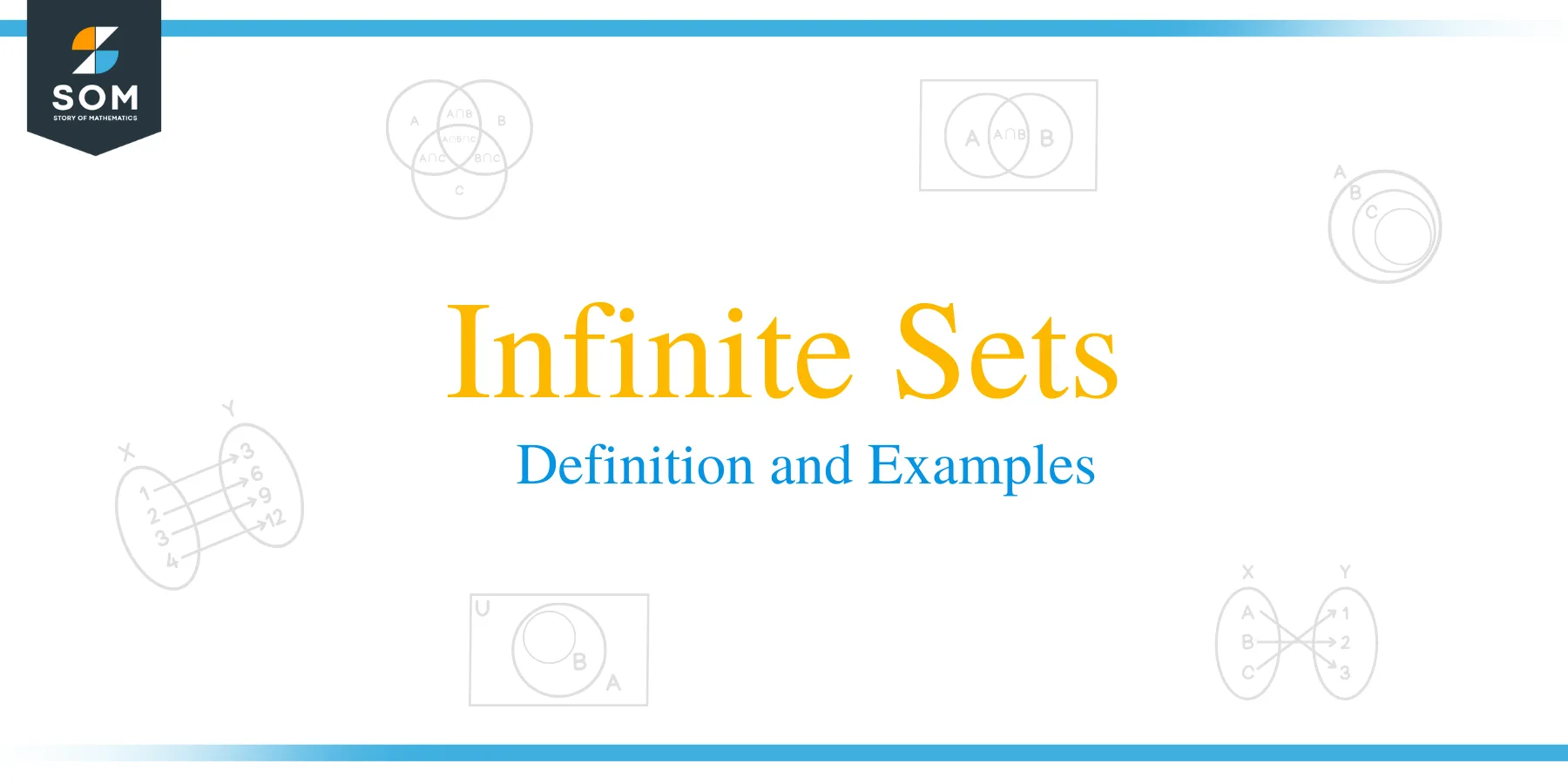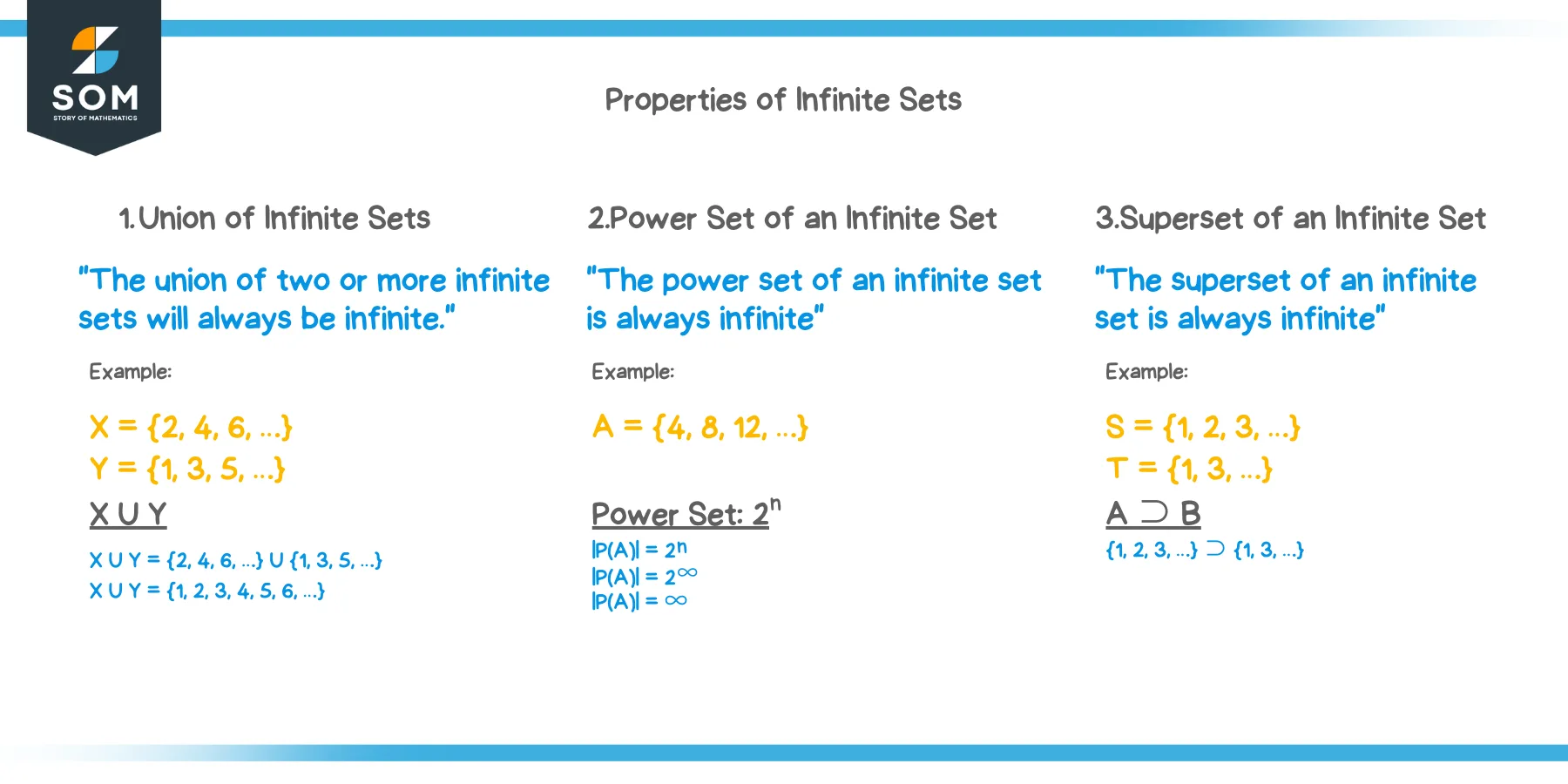- Home
- >
- Infinite Sets – Explanation & Examples
JUMP TO TOPIC
Infinite Sets – Definition & Examples
 In mathematics, we use sets to classify numbers or items. We can broadly divide sets into two main segments: Finite and Infinite sets.
In mathematics, we use sets to classify numbers or items. We can broadly divide sets into two main segments: Finite and Infinite sets.
In the previous lesson, we classified countable items, and we achieved this by using finite sets. But what if the items or numbers laid down before us are not countable? The answer will be much more straightforward if we are familiar with the concept of infinite sets.
This article will explain Infinite Sets so you can understand them and know where to use them.
Infinite sets are the sets containing an uncountable or infinite number of elements. Infinite sets are also called uncountable sets.
The topics we will cover in this article are:
- What is an infinite set?
- How to prove that a set is infinite?
- Properties of infinite sets.
- Examples
- Practice Problems
It would also help you understand Infinite Sets much better if you think you need a quick refresher on the following:
What is an Infinite Set?
“What is an infinite set?” is a common question fresh math enthusiasts ask, and they’re applicable in real-life scenarios. But we cannot count everything in real-life, so we classify these uncountable items and numbers by using infinite sets. What you need to remember is that the elements in an infinite set do not have any ending point.
There are multiple examples of infinite sets and items around us: the stars in the midnight sky, water droplets, and the millions of cells in the human body. But in mathematics, the ideal example of an infinite set is a set of natural numbers. The set of natural numbers is unlimited and has no end. Hence the same classification/criteria go for infinite sets.
Another thing to remember is that mathematics is not all about definite number systems. Graphically, we can plot a maximum of 2 or 3 axes, and using the same graph, uncountable or infinite points exist and can be declared as infinite sets.
Similarly, a line segment may appear as a straight line with some definite magnitude, but infinite points join up to make a line segment on a microscopic level. These infinite points are also examples of infinite sets.
Unlike finite sets, an infinite set does not need to have a definite start. A set of integers is one good example. Consider the following set of integers Z:
Z = {…, -2, -1, 0, 1, 2,…}
Notation of an Infinite Set:
The notation of an infinite set is like any other set with numbers and items enclosed within curly brackets { }. However, we can distinguish infinite from finite sets by using ellipses (…)
Ellipses indicate that a set has no ending point or that a set contains unlimited or infinite elements. We can also represent infinite sets using any letter, word, or even a phrase.
Let us consider an infinite number system A. This number system A can have the following notation.
A = {1, 2, 3, …}
We mentioned earlier that we could also represent infinite sets by any letter, word, or phrase. Thus, the same number system A can have the following notations as well:
Number System = {1, 2, 3, …}
Or
X = {1, 2, 3, …}
Some more examples of infinite sets are given below:
Whole Numbers = {0, 1, 2, 3, …}
X = {x : x is an integer and -4<x<∞}
E = {2, 4, 6, …, 2n}
here ‘n’ denotes any number.
Some examples of infinite sets are as follows:
Example 1
Identify whether the following sets are infinite sets.
(i) Line segments in a plane.
(ii) Multiples of 3.
(iii) Factors 45.
Solution
(i) An infinite number of line segments in multiple directions can exist within a plane. Hence, the set of line segments in a plane is an infinite set. It will have the following notation:
Line Segments in a plane = {1, 2, 3, …, n}
Where ‘n’ can be any integer.
(ii) Since no ending limit to the multiples of 3 is given in the question, therefore, multiples of 3 are also an infinite set. It will have the following notation:
Multiples of 3 = {3, 6, 9, …, 3n}
Where ‘n’ can be any integer.
(iii) Upon factorizing 45, we obtain the numbers 1, 3, 5, 9, and 45 as factors. Since the total number of these factors is limited, which is 5, 45 is not an infinite set.
How to Prove a Set is Infinite?
To prove that a set is infinite, we will check its cardinality. As discussed in the lesson on finite sets, cardinality is indicated by the set’s total number of elements. However, infinite sets contain unlimited elements, which means their cardinality is not a definite number and is denoted by aleph-null (ℵ0).
Another unique factor of infinite sets is that they cannot have a one-to-one correspondence or a bijective relation with any reference set.
Let us evaluate this further. Consider a reference set R, which is given below:
R = {1, 2, 3, …}
Now, consider an infinite set A:
A = {0, 1, 2, …}
Both sets R and A have unlimited elements, so their cardinality is not definite and can be termed aleph-null (ℵ0). Furthermore, both sets R and A’s definite ending is not predictable because we cannot form a bijective relation between the two sets. Hence, the sets R and A are infinite sets.
The following theorems can also help us to prove if a set is infinite:
Theorem 1:
Let A and B be two sets. If A is an infinite set and A ≅ B, then B is also an infinite set.
In this theorem, sets A and B are approximately equal to one another.
Example 2
If A is an infinite set and A = {5, 10, 15, …, 35, …}, then prove that B is also an infinite set given that B = {5, 10, 15, …, 50, …}.
Solution
This example can be solved in the light of the above theorem.
According to theorem 1:
A ≅ B
Now, let’s compare the two sets:
{5, 10, 15, …, 35, …} ≅ {5, 10, 15, …,50, …}
Both the sets are approximately equal due to the similar elements they share, but both possess the cardinality aleph-null (ℵ0).
Since set A is an infinite set, so set B is also an infinite set.
Theorem 2:
Let A and B be two sets. If A is an infinite set and A ⊆ B, then B is also an infinite set.
In this theorem, set B is the power subset of set A.
Example 3
If A is an infinite set and A= {1, 3, 5, …}, then prove that B is also an infinite set given that B = {3, 5, …}.
Solution
We will use theorem 2 to solve this example.
According to theorem 2:
A ⊆ B
{1, 3, 5, …} ⊆ {3, 5, …}
It is clear that set A is an infinite set, and set B is the power subset of set A; hence, set B is also an infinite set.
Properties of Infinite Sets
Infinite sets massively solve the dilemma of sorting the uncountable elements in mathematics. Although infinite sets classify more than half of the realm of mathematics, it is still necessary to evaluate some of the properties of infinite sets to simplify calculations involving infinite sets. These properties will also help us in developing a sound understanding of the infinite sets.
1. Union of Infinite Sets
The union of two or more infinite sets will always be infinite.
The union of sets is a way to combine two or more sets into a single set. The union of sets shows the combined elements that were contained in all the sets individually.
The union of two or more infinite sets will always be infinite as the sets being unified have unlimited elements in them. As a result, their joint set will also contain unlimited elements.
We can understand this property better with the help of an example.
Example 4:
Consider two sets X = {2, 4, 6, …} and Y = {1, 3, 5, …}. Prove that their union is also an infinite set.
Solution
The two sets, X and Y, are infinite as both have unlimited elements in them.
We can express their union as:
X U Y = {2, 4, 6, …} U {1, 3, 5, …}
X U Y = {1, 2, 3, 4, 5, 6, …}
Since both X and Y are infinite sets and have the aleph-null (ℵ0) cardinality, their union is also infinite and has the cardinality aleph-null (ℵ0).
2. Power Set of an Infinite Set
The power set of an infinite set is always infinite.
The power set is the total number of subsets of a given set, including the null set and the set itself. The following formula can calculate it:
|P(A)| = $2^n$
Since an infinite set has unlimited elements, the power set of an infinite set will also be infinite as the set will have infinite subsets.
Let’s solve an example to verify this property.
Example 5:
Prove that the power set of A = {4, 8, 12, …} is infinite.
Solution:
To find the power set, we will use the following formula:
|P(A)| = $2^n$
Since the number of elements in set A is infinite, so:
|P(A)| = $2^∞$
|P(A)| = ∞
Hence, it is proven that the power set of an infinite set is infinite.
3. Superset of an Infinite Set
The superset of an infinite set is always infinite.
A set A is the superset of another set B is all the elements of B are present in A. The notation of superset is shown below:
A ⊃ B
Consider a set A, which is an infinite set. Its superset will also be an infinite set as it will also contain unlimited elements.
Let us evaluate the following example to understand this property.
Example 6
Prove that the superset S = {1, 2, 3, …} of the infinite set T = {1, 3, …} is also an infinite set.
Solution
The set T is an infinite set, and its superset is set S.
According to the above property:
A ⊃ B
And,
{1, 2, 3, …} ⊃ {1, 3, …}
So this proves that the superset S is also an infinite set.
To further strengthen the understanding and the concept of the infinite set, consider the following practice problems.
Practice Problems
- Check which of the following sets are infinite:
(i) Multiples of 100.
(ii) Factors of 225.
- If A is an infinite set and A = {22, 44, 66, …, 100} and B = {22, 44, …, 100}, prove that B is also an infinite set.
- If A is an infinite set and A = {100, 105, 110, …} and B = {100, …}, prove that B is also an infinite set.
- Find if the union of the 2 infinite sets X = {3, 6, 9, …} and Y = {7, 14, 28, …} is also infinite.
- Find if the powerset of the following are infinite or not:
(i) A = {3, 4, 6, …}
(ii) B = {4, 5, 7, 8}
Answers
- (i) Infinite (ii) Not infinite
- Infinite
- Infinite
- Infinite
- (i) Infinite (ii) Not infinite
